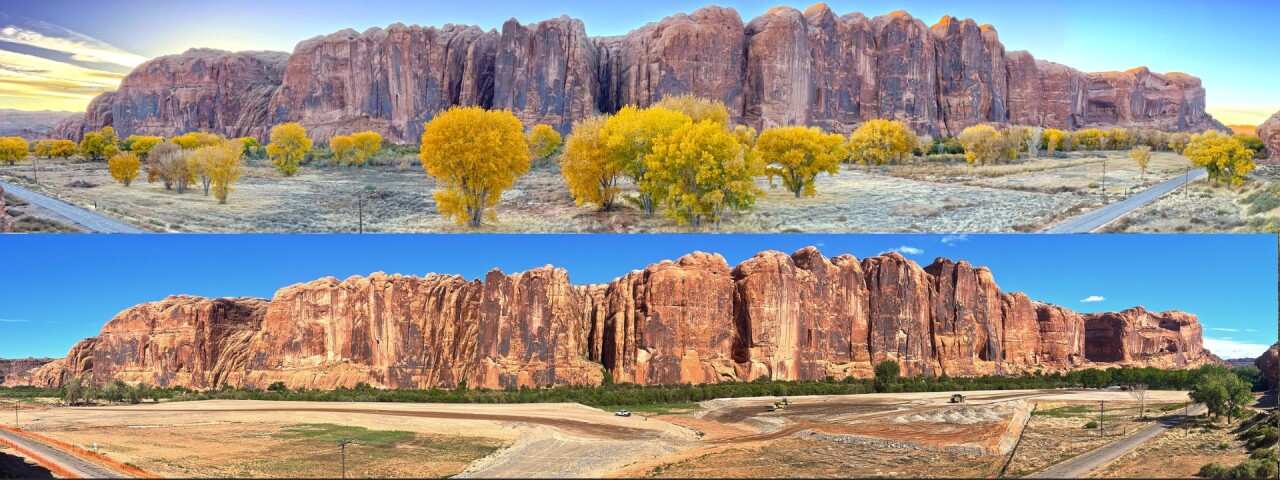MOAB, Utah — For six years, John Scofield called Kane Creek home.
“It's a really beautiful place and a very important spot on the Colorado River,” he said. “It's also right next to one of the largest wetlands in Utah. It's an amazing spot, and it was a huge sanctuary for a lot of deer and animals.”
At the end of 2022, Scofield was evicted from the Navajo structure he was living in on the hill of the floodplain, he said.
“It was one of the sanctuaries for low-income housing out here,” said Scofield. “There was families that lived right here, and when this developer bought the property, they gave us one month to get out into the middle of winter.”
A year later, Moab residents watched the large cottonwood trees fall to the ground.

“The most concerning aspect was seeing the area being bulldozed and all the wildlife being pushed out and seeing the native trees ripped down,” said Jesse Faircloth.
Kane Creek Preservation and Development LLC has plans to build a luxury, resort-style housing development on its 180-acre property, surrounded by Bureau of Land Management land.
“Kings Bottom is... a flood deposit,” said John Weisheit, the conservation director of Living Rivers. “It was created by the Colorado River, and so to put luxury expensive homes on a floodplain is morally wrong.”
These once-a-century floods are becoming more and more frequent, and when Kane Creek Boulevard floods, Weisheit says there’s no other way in and out of this area.
“It has already happened, and it will happen again,” he said. “People need to understand that their property and their lives are in danger if they buy into this development.”

Trent Arnold, one of the three developers of the project, believes this development is what Moab needs to survive.
“In an area like Moab, which is highly constrained in terms of housing supply, as well as its developable land supply, it is interesting to look at other markets like this that have not grown out, or not addressed kind of the trends that are happening in them,” he said. “You see an increase in everyone's housing stock, and there's supply constraint.”
The developers are trying to stay obscured after receiving threats, Arnold told FOX 13 News over the phone, not wanting to show his face in an interview.
Arnold addressed people’s concerns about harm to the precious ecosystem.
“This property is zoned for almost 2,500 units, and our current plan has this building somewhere between 280 and 580 units, and it'll probably be closer to the lower side of that range,” he said. “By our design, before we ever start anything, we're already a lot lighter on the land than what could be there.”
Arnold said they plan to lift the site of the homes and the road to mitigate flood risk.
“We're building up the site to be above the 100-year floodplain, and in some cases above the 500-year floodplain,” he said. “At that elevation, we are now out of the floodplain in a way that almost a third of the town of Moab is not.”
One question many are asking: How is this development legal?
“In 1992, when all this was beginning, the people who lived here at that time were desperate for something to keep this town alive,” said Sam Cunningham, a former Grand County Commissioner. “This town was dying.”
A previous property owner asked for permission to develop a small campground, she said.
“It could pave the way for other people to do the same thing on their property, and yet not change the whole feeling, or the ecology, of where it was,” said Cunningham. “He had a large portion there. He had, I believe 180 acres, but he only wanted 10 acres developed.”
The mystery is that some time in the last few decades when the property changed hands, the re-zone stated that all of the land could be developed, she said.
“All I know is what we okayed was not turned into law,” said Cunningham. “That's all I know.”
Currently, residents are fighting to repeal a bill passed in this last legislative session, which allows developers to create a "preliminary municipality" out of the land they own.
“They basically can create a city here without any residents and make all their own laws,” said Dailey Haren. “It appears that this law was specifically tailored for this development.”
Despite a lack of funds, community members are trying to find a way they can to stop this development. When asked if the developers are worried about strong community reaction preventing the project from completion, Arnold responded with confidence.
“We're in our legal rights, and we're well capitalized,” he said.




